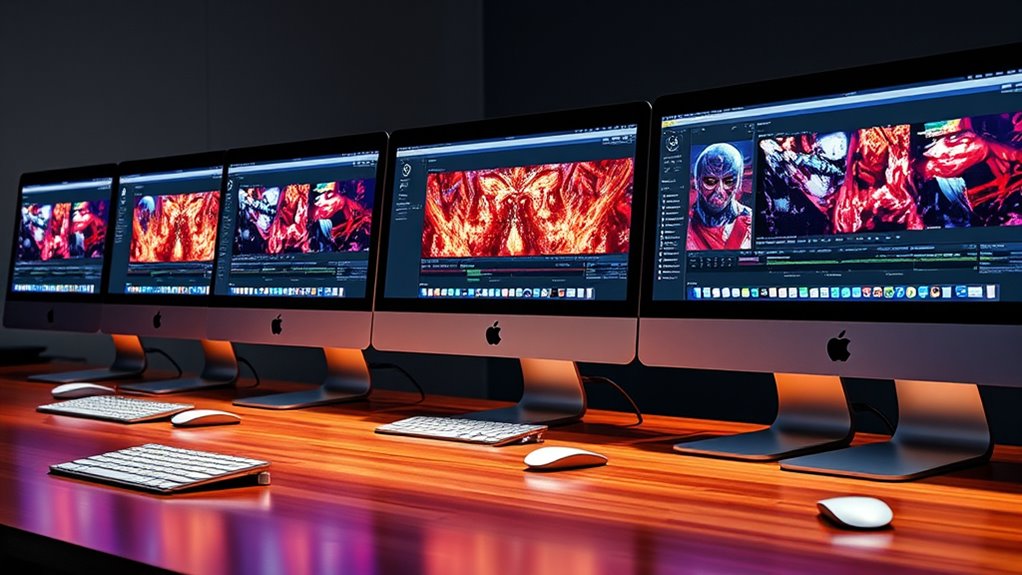If you’re looking for the best iMacs for video editing in 2025, I recommend models with the latest M4 chip, powerful GPU options, and stunning 4.5K Retina displays supporting billions of colors. These iMacs offer top performance, vibrant visuals, and ample memory for demanding workflows. Their sleek, portable design is perfect for creative professionals. Keep exploring to find out which specific models deliver the best power, performance, and precision for your editing needs.
Key Takeaways
- Look for iMac models with M4 chips, offering powerful CPU and GPU options for smooth video editing workflows.
- Prioritize high-resolution Retina displays (4.5K or higher) with excellent color accuracy and brightness for precise editing.
- Choose models with ample RAM (16GB or more) and increased VRAM to handle large video files and complex projects efficiently.
- Consider connectivity options like Thunderbolt 4 and multiple USB-C ports for external drives and peripherals.
- Opt for sleek, portable designs in vibrant colors that complement modern creative workspaces in 2025.
Apple 2024 iMac All-in-One Desktop Computer with M4 Chip
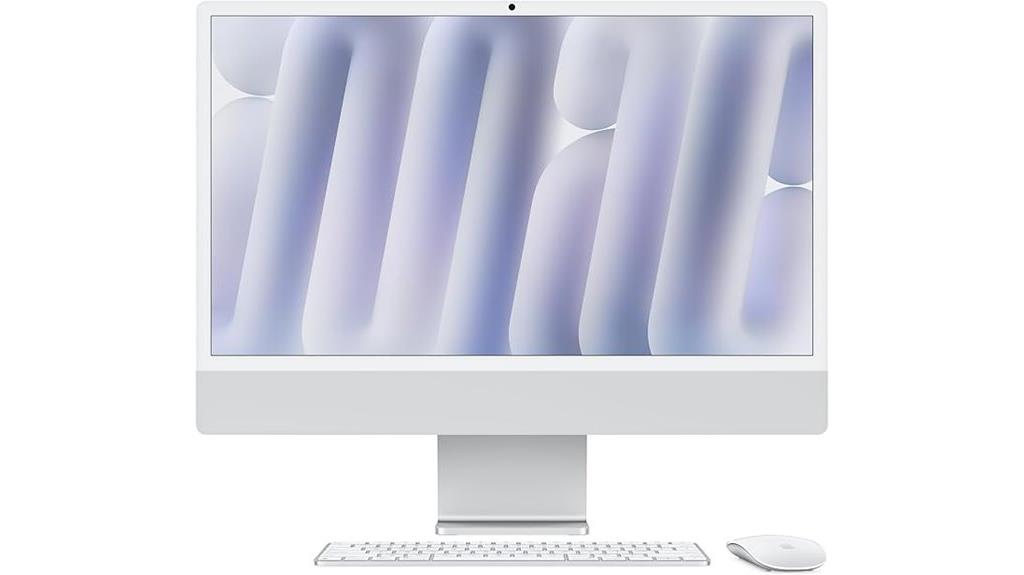
If you’re looking for a powerful all-in-one desktop that combines stunning visuals with top-tier performance, the Apple 2024 iMac with the M4 chip is an excellent choice for video editing. Its sleek, thin design in seven vibrant colors adds style to any workspace. The 24-inch Retina display with 4.5K resolution and support for a billion colors offers immersive visuals. Powered by the M4 chip with an 8-core CPU and GPU, it handles multitasking and editing smoothly. With 16GB of unified memory and a 256GB SSD, performance is responsive and fast, making it ideal for demanding creative tasks.
Best For: creative professionals and power users seeking a sleek, high-performance all-in-one desktop ideal for video editing, multitasking, and immersive visuals.
Pros:
- Stunning 24-inch Retina display with 4.5K resolution and support for a billion colors
- Powered by the efficient M4 chip with an 8-core CPU and GPU for smooth multitasking and editing
- Vibrant design options in seven colors that enhance any workspace
Cons:
- Limited storage capacity with 256GB SSD, which may require external options for large files
- Higher price point typical of Apple’s premium products
- All-in-one design means less upgradeability or customization post-purchase
Apple 2024 iMac Desktop Computer with M4 Chip

The Apple 2024 iMac with the M4 chip is an excellent choice for creative professionals who need powerful performance in a sleek, compact design. Its 24-inch Retina 4.5K display supports up to 1 billion colors and offers vibrant visuals, ideal for editing videos and photos. Powered by the 10-core M4 CPU and GPU, along with 16GB of unified memory and 512GB SSD storage, it handles multitasking and demanding apps effortlessly. While it has four USB-C ports, it lacks traditional USB-A ports, so adapters are necessary. Overall, this iMac combines stunning aesthetics with impressive performance, making it a versatile tool for creative work.
Best For: creative professionals and small businesses seeking a powerful, stylish all-in-one desktop with vibrant display and reliable performance.
Pros:
- Stunning 24-inch Retina 4.5K display supporting up to 1 billion colors for vivid visuals
- Powerful M4 chip with 10-core CPU and GPU delivering fast multitasking and demanding app performance
- Sleek, colorful design available in seven vibrant options that fit well in various environments
Cons:
- Lacks traditional USB-A ports, requiring adapters or hubs for external devices
- Limited external display support with only two external monitor connections
- No printed instructions, making initial setup reliant on online resources
Apple 2024 iMac Desktop Computer with M4 Chip
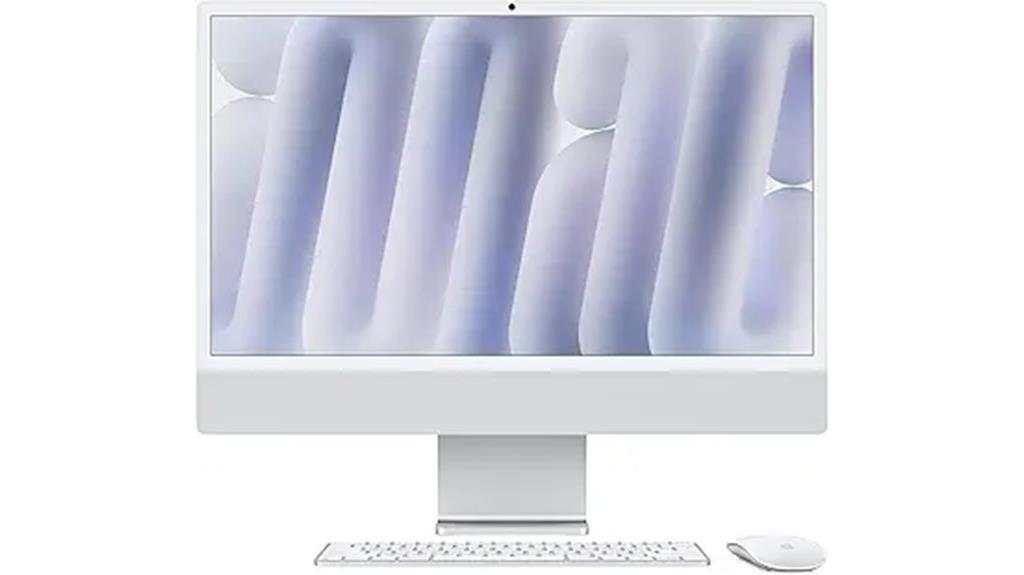
Creative professionals seeking a sleek, all-in-one machine will find the Apple 2024 iMac with M4 Chip an excellent choice, thanks to its stunning 24-inch Retina 4.5K display that delivers vibrant colors and sharp detail. Powered by the M4 chip with a 10-core CPU and GPU, it offers fast, reliable multitasking, photo editing, and heavy processing. With 24GB of unified memory and a 512GB SSD, performance remains smooth. Its design is vibrant and slim, fitting seamlessly into any workspace. The iMac also features a 12MP Center Stage camera, immersive audio with six speakers, and supports external connectivity through four USB-C ports, making it a versatile creative tool.
Best For: creative professionals and multitaskers seeking a sleek, high-performance all-in-one desktop with stunning visuals and reliable power.
Pros:
- Vibrant 24-inch Retina 4.5K display with rich color accuracy
- Powerful M4 chip with 10-core CPU and GPU for smooth multitasking and heavy processing
- Elegant, slim design available in multiple vibrant colors that fit seamlessly into any workspace
Cons:
- Lacks traditional USB-A ports, requiring adapters or hubs for older peripherals
- Limited support for external displays (up to two monitors)
- Some users may experience setup challenges due to minimal included instructions
Apple 2024 iMac Desktop Computer with M4 Chip
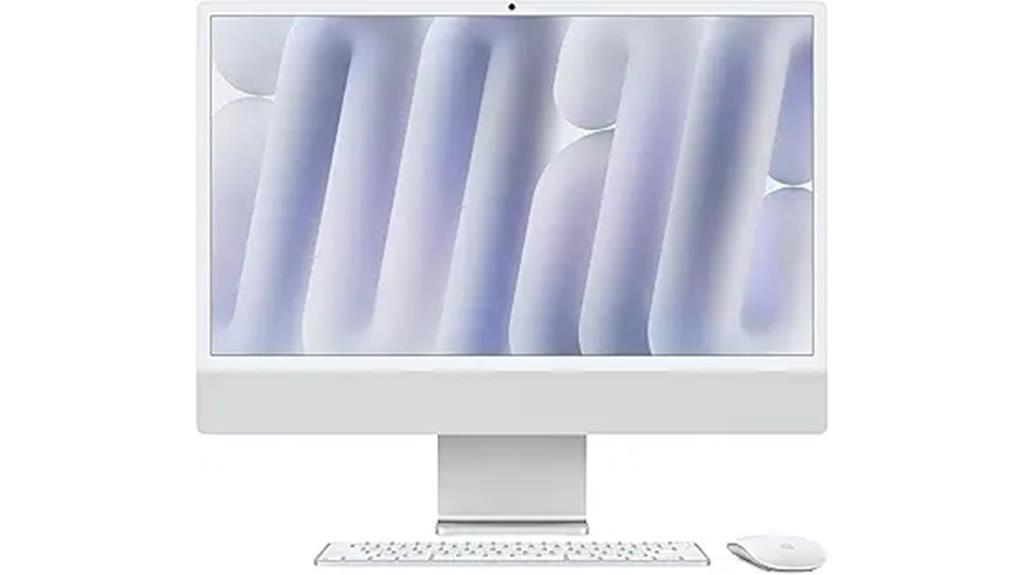
For anyone seeking a sleek, powerful all-in-one desktop dedicated to video editing, the Apple 2024 iMac with M4 chip stands out as an excellent choice. It features a 10-core CPU and GPU, a stunning 24-inch 4.5K Retina display supporting up to 1 billion colors, and vibrant color options. Weighing just under 10 pounds, it’s compact and stylish, with Nano-Texture Glass for enhanced visuals. Powered by the M4 chip, it handles multitasking and demanding creative tasks smoothly, running applications like Adobe Creative Cloud effortlessly. While it offers excellent performance, you’ll need external storage and adapters for full connectivity, but overall, it’s a top-tier option for video editors.
Best For: creative professionals and video editors seeking a sleek, high-performance all-in-one desktop with stunning display quality and vibrant design.
Pros:
- Powerful M4 chip with 10-core CPU and GPU ensures smooth multitasking and demanding creative tasks
- Stunning 24-inch 4.5K Retina display with Nano-Texture Glass provides vivid visuals supporting up to 1 billion colors
- Compact, stylish design with vibrant color options enhances any workspace and is easy to set up
Cons:
- Limited to connecting only two external displays, which may be restrictive for some users
- Lacks traditional USB-A ports, requiring adapters or hubs for legacy device compatibility
- External storage solutions and adapters are necessary for additional storage and connectivity needs
Apple 2024 iMac Desktop Computer with M4 Chip

If you’re looking for a sleek, powerful all-in-one desktop that handles demanding video editing tasks with ease, the Apple 2024 iMac with M4 chip is an excellent choice. It features a 10-core CPU and GPU, a stunning 24-inch Retina 4.5K display supporting 1 billion colors, and 16GB of unified memory. Its vibrant design comes in seven colors, making it both stylish and functional. Although it has limited ports—only two Thunderbolt/USB-C ports—you can expand connectivity with hubs. With fast performance, immersive visuals, and a sleek aesthetic, this iMac is ideal for creative professionals seeking power and elegance in one package.
Best For: creative professionals and power users seeking a sleek, high-performance all-in-one desktop for demanding tasks like video editing and design.
Pros:
- Stunning 24-inch Retina 4.5K display with vibrant colors and high brightness.
- Powerful M4 chip with 10-core CPU and GPU for fast multitasking and creative workflows.
- Stylish, colorful design that seamlessly fits into modern workspaces.
Cons:
- Limited to two Thunderbolt/USB-C ports, requiring hubs or adapters for additional connectivity.
- No physical instructions included, which may complicate initial setup.
- External storage expansion and peripheral compatibility may require additional accessories.
Apple 2024 iMac Desktop Computer with M4 Chip

The Apple 2024 iMac Desktop Computer with M4 Chip stands out as an excellent choice for video editors who need powerful performance in a sleek, compact design. Its 24-inch Retina 4.5K display supports up to 1 billion colors with bright, vibrant visuals—perfect for detailed editing. Powered by the M4 chip with a 10-core CPU and GPU, 16GB unified memory, and 512GB SSD, it handles demanding tasks effortlessly. Its slim, colorful body adds aesthetic appeal to any workspace. Although it offers four USB-C ports and no USB-A, the iMac’s speed, clarity, and stylish design make it a compelling option for creative professionals.
Best For: creative professionals, especially video editors and artists, seeking a powerful, stylish, and compact desktop with vibrant display capabilities.
Pros:
- Stunning 24-inch Retina 4.5K display supports up to 1 billion colors for detailed visual work
- Powerful M4 chip with 10-core CPU and GPU delivers fast, reliable performance for demanding tasks
- Sleek, colorful design enhances workspace aesthetics and fits well in various environments
Cons:
- Limited external display support, only up to two monitors, which may restrict multi-monitor setups
- No traditional USB-A ports, requiring adapters or hubs for external devices
- Absence of printed instructions may necessitate reliance on online resources for setup and troubleshooting
Factors to Consider When Choosing an Imac for Video Editing
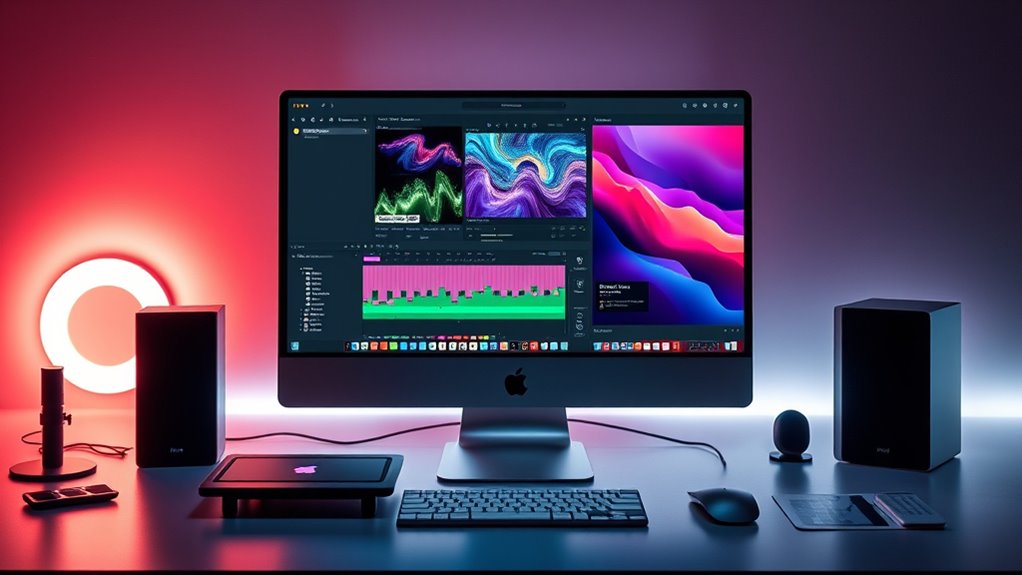
When selecting an iMac for video editing, I focus on display quality and size to guarantee clear visuals. Processing power and memory are essential for handling demanding projects smoothly, while graphics capabilities enhance rendering and effects. Additionally, I consider connectivity options to support peripherals and storage choices for efficient workflow.
Display Quality and Size
Have you ever wondered how display quality and size influence your video editing experience? Larger screens give you more space to work on detailed timelines and manage multiple windows effortlessly. Higher resolution, like 4.5K or 5K, ensures crisp, clear images, which is crucial for spotting fine details in your videos. Support for up to a billion colors guarantees accurate color representation, essential for professional color grading. Brightness levels around 500 nits improve visibility in various lighting conditions, helping you see true colors and details. Retina displays with high pixel density deliver smooth visuals and reduce eye strain during long editing sessions. Ultimately, a bigger, high-quality display enhances precision and comfort, making your workflow more efficient and enjoyable.
Processing Power and Speed
Choosing an iMac with powerful processing capabilities is essential for smooth video editing. A higher core count, like 8 or 10 cores, speeds up rendering and handles high-resolution footage more efficiently. A CPU with strong single-thread performance guarantees responsive editing software, especially during complex timeline adjustments. Faster processing speeds cut down export times, making workflow more efficient. Additionally, sufficient processing power allows real-time playback of high-bitrate footage without buffering or lag, keeping editing seamless. The latest chips, such as Apple’s M4, integrate GPU capabilities that accelerate effects rendering and video processing, further boosting performance. Overall, prioritizing processing power means smoother editing, quicker project turnaround, and a more reliable creative experience.
Memory and Storage Options
To guarantee smooth video editing, I recommend opting for at least 16GB of unified memory, which handles multitasking and large files more efficiently. When working with 4K or higher resolutions, faster memory can make a noticeable difference in rendering times and overall performance. Storage is equally important; I suggest models with 512GB SSD or more to comfortably store large video projects and minimize reliance on external drives. Larger SSDs improve editing workflows by enabling quicker file access and reducing bottlenecks. If internal storage is limited, external SSDs or hubs can supplement space without sacrificing speed. For professional workflows, higher memory and storage configurations ensure seamless editing, faster exports, and less downtime, making your investment more future-proof and efficient.
Graphics Capabilities
A powerful graphics card or GPU plays a vital role in guaranteeing smooth video editing workflows. It enables real-time rendering and playback of high-resolution footage, making editing more efficient. Apple’s M4 chips with 8-core or 10-core integrated GPUs can handle most tasks effectively without a dedicated GPU, offering excellent performance for everyday editing. However, for more demanding projects, higher GPU core counts can markedly speed up rendering times and improve performance when applying effects or working with 4K and higher resolutions. VRAM also matters—more video memory allows for smoother handling of complex projects with multiple layers and detailed effects. Additionally, an optimized GPU architecture and software compatibility ensure hardware acceleration, resulting in a seamless editing experience.
Connectivity and Ports
When selecting an iMac for video editing, considering its connectivity options is essential to guarantee a smooth workflow. You want enough ports, like USB-C or Thunderbolt, to connect external drives and peripherals efficiently. Supporting multiple external displays, ideally two or more, helps manage your workspace better and streamlines editing tasks. It’s also important to check if adapters or hubs are needed, especially since newer models might lack traditional USB-A ports, which could affect compatibility with older accessories. Additionally, confirm the data transfer speeds supported by the ports—Thunderbolt 4 or USB 3.2 are ideal for handling large video files quickly. Ultimately, evaluate the number and type of ports to ensure seamless integration with your existing storage, monitors, and audio or video equipment.
Software Compatibility
Choosing an iMac for video editing means ensuring its software support keeps your workflow smooth and efficient. I check that the operating system supports the latest versions of key editing programs like Final Cut Pro, Adobe Premiere Pro, or DaVinci Resolve. It’s essential that the hardware meets both minimum and recommended specs—especially GPU, CPU, and RAM—to handle demanding tasks without lag. I also verify compatibility with external plugins, codecs, and file formats I use regularly, avoiding import or export issues. Additionally, I look for hardware acceleration features that speed up rendering and exporting. Finally, I confirm the iMac’s software ecosystem integrates seamlessly with other tools and peripherals in my workflow, creating a cohesive, productive editing environment.
Frequently Asked Questions
How Does the M4 Chip Enhance Video Editing Capabilities?
The M4 chip considerably boosts my video editing by offering faster processing speeds, improved multitasking, and better energy efficiency. Its advanced architecture handles high-resolution footage seamlessly, reducing render times and enabling real-time editing without lag. With enhanced graphics and AI capabilities, I notice sharper visuals and smarter editing tools. Overall, the M4 chip lets me work more efficiently, producing professional-quality videos with less frustration and more creative freedom.
What Software Compatibility Is Optimized for the 2025 Imacs?
When it comes to software compatibility on the 2025 iMacs, you’ll find a perfect blend of legacy and cutting-edge programs. I’ve noticed that Apple’s native apps like Final Cut Pro and Logic Pro run seamlessly, while many third-party editors, including Adobe Premiere and DaVinci Resolve, get optimized updates for the M4 chip. This mix guarantees I can edit smoothly with familiar tools, plus enjoy the latest innovations without compromise.
Are Upgrade Options Available for Storage and RAM?
Yes, I can upgrade the storage and RAM on the 2025 iMacs. Apple offers configurable options at purchase, allowing me to choose larger SSDs and more RAM to suit my editing needs. Additionally, some models might let me upgrade RAM later, but storage upgrades usually require purchasing a larger SSD upfront. I recommend checking the specific model’s upgrade policies to ensure I get the best setup for my video editing workflow.
How Does Display Quality Impact Editing Precision?
Display quality directly impacts my editing precision because a sharp, color-accurate screen allows me to see every detail accurately. Higher resolution and better color gamut help me make precise cuts and color corrections without guesswork. When I use a display with excellent contrast and true-to-life colors, I feel more confident in my edits, ensuring my final video looks professional and polished. Good display quality is essential for accurate, high-quality work.
What Peripherals Are Recommended for Professional Video Editors?
For professional video editing, I recommend a high-quality external monitor with accurate color reproduction, like a calibrated 4K or 6K display, along with a precise color calibration tool. A reliable external hard drive or SSD is essential for fast media access, and a good set of headphones or studio monitors can help with sound editing. Additionally, a professional-grade graphics tablet can enhance detailed work, making your editing process smoother and more accurate.
Conclusion
Choosing the right iMac for video editing is like assembling a puzzle—you need the right pieces to see the full picture clearly. After testing several models, I’ve found that the M4 chip-powered iMacs offer the power and precision I need, much like a finely tuned orchestra. When you pick the right machine, your creativity flows seamlessly—turning your ideas into polished videos, just like a master artist brings a blank canvas to life.
